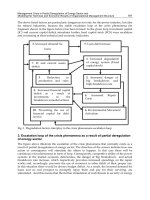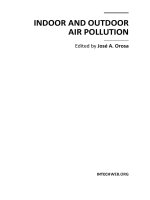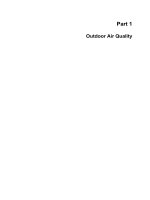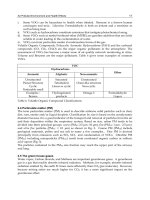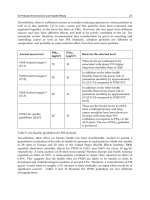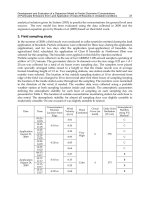Indoor and Outdoor Air Pollution Part 11 potx
Bạn đang xem bản rút gọn của tài liệu. Xem và tải ngay bản đầy đủ của tài liệu tại đây (2.09 MB, 10 trang )
Correlation of Professional Performance to Acceptable IAQ in Critical Care Medical Facilities
91
Fig. 11. Improper site grading.
A value engineering (VE) exercise resulted in the use of direct expansion (DX) roof top units
with coils that had a sensible heat ratio too high to effectively dehumidify. Exhaust fans
were VE and as a result the fans were located below the roof which was a violation of [Title
25, Texas Administrative Code, Chapter 133, Hospital Licensing State Regulations (HLSR)
2007]. It was obvious that the VE items selected were money driven and health and safety
concerns and/or the HLSR rules were ignored. Without an architects CA services in place to
mind the store and with an unsophisticated owner, the contractor and his subcontractors
did whatever they wanted to do. Negative building pressure and improper pressure
relationships were the major contributor to the poor physical environment. Pressure
relationships between critical care areas inside the building with respect to other spaces
were not in accordance with HLSR. Both design and installation defects contributed to these
conditions. The design of the HVAC system was inadequate for humidity control. Engineers
know that buildings located in hot and humid climates need HVAC systems designed to
work in that climate yet only the dry-bulb/coincident wet-bulb design condition was
considered for coil selections. A test, adjust, balance, and commissioning process was
obviously never completely performed for the performance aspects of the project other than
the air volume measurements. The HVAC control system was deficient in that it was never
commissioned to control to the various pieces of equipment as an integrated system. In fact
the maintenance staff at the facility was never trained to operate the system and they had to
resort to an on-line third party provider for day-to-day control.
In a response to uncontrolled high indoor humidity, areas were over-cooled including OR,
which resulted in frequent condensation on the interior surfaces, medical equipment, and
supplies to the extent surgeries had to be rescheduled or cancelled. Water stained building
materials, indoor mold growth, temperature fluctuations, high humidity, and condensation
all contributed to an unsatisfactory environment for patients and staff and violated state
licensing rules.
Indoor and Outdoor Air Pollution
92
Rule # Subject HVAC Violation (rule language)
§133.162.(d)(3)
General
Mechanical
Requirements
All rooms and areas in the ASC shall have provision for
positive ventilation. The ventilation rates shown in Table
1 of §135.56(a) of this title shall be used onl
y
as minimum
requirements, since the
y
do not preclude the use of
higher rates that may be appropriate.
(C)
Performance and
acceptance
Prior to completion and acceptance of the facilit
y
, all
mechanical s
y
stems shall be tested, balanced, and
operated to demonstrate to the desi
g
n en
g
ineer or his
representative that the installation and performance of
these s
y
stems conform to the requirements of the plans
and specifications.
(C)(i) Material lists
Upon completion of the contract, the owner shall be
provided with parts lists and procurement information
with numbers and description for each piece of
equipment.
(D)(i)(III)
Outside air
location
Outside air intakes shall be located at least 25 feet from
exhaust outlets of ventilatin
g
s
y
stems, combustion
equipment stacks, medical- sur
g
ical vacuum s
y
stems,
plumbin
g
vents, or areas which ma
y
collect vehicular
exhaust or other noxious fumes. (Prevailin
g
winds and
proximit
y
to other structures ma
y
require more strin
g
ent
requirements). Plumbin
g
and vacuum vents that
terminate five feet above the level of the top of the air
intake may be located as close as 10 feet.
(D)(i)(VI)
Directional air
flow
Ventilation s
y
stems shall be desi
g
ned and balanced to
provide directional flow as shown in Table 3 of
§133.169(c) of this title. For reductions and shutdown of
ventilation s
y
stems when a room is unoccupied, the
provisions in Note 4 of Table 3 of §133.169(c) of this title
shall be followed.
(D)(i)(IX)
Humidifier
location
When duct humidifiers are located upstream of the final
filters, the
y
shall be located at least 15 feet from the
filters. Ductwork with duct- mounted humidifiers shall
be provided with a means of removin
g
water
accumulation. An adjustable high-limit humidistat shall
be located downstream of the humidifier to reduce the
potential of condensation inside the duct.
(D)(iv)(II)
Smoke removal
systems
Smoke removal s
y
stems for sur
g
ical suites. Smoke
removal s
y
stems shall be provided in all sur
g
ical suites
in accordance with NFPA 99, §6.4.1.3.
(D)(vii)
Fire damper
requirements
Fire dampers shall be located and installed in all ducts at
the point of penetration of a required two-hour or hi
g
her
fire rated wall or floor in accordance with the
requirements of NFPA 101, §18.5.2.
Correlation of Professional Performance to Acceptable IAQ in Critical Care Medical Facilities
93
Rule # Subject HVAC Violation (rule language)
(D)(viii)
Smoke damper
requirements
Smoke dampers shall be located and installed in
accordance with the requirements of NFPA 101, §18.3.7.3,
and NFPA 90A, Chapter 5.
(D)(xii) Make-up air
If air suppl
y
requirements in Table 3 of §133.169(c) of this
title do not provide sufficient air for use b
y
exhaust hoods
and safety cabinets, filtered make-up air shall be ducted to
maintain the required air flow direction in that room.
§133.162.(d)(4)
General Piping
Systems and
Plumbing
Fixture
Requirements
All pipin
g
s
y
stems and plumbin
g
fixtures shall be
desi
g
ned and installed in accordance with the
requirements of the National Standard Plumbin
g
Code
Illustrated published b
y
the National Association of
Plumbing-Heating-Coolin
g
Contractors (PHCC), 2003
edition, and this paragraph.
Table 2. Ten of forty-four rules in HLSR for HVAC systems were noncompliant.
3.3 Case study 3 (“CS 3”)
This single story hospital was constructed in 2009. It was 70,000 square feet and constructed
under the more traditional design/bid/build delivery system. Its exterior was composed of
concrete masonry units with accent bands of cast stone. In the previous two studies the issue
of prime importance was water intrusion caused by site and envelope issues and the
inability of the HVAC systems to control the environment. Water intrusion was an issue in
this case, however, the prime concern was an unsecured envelope that allowed unacceptable
levels of particulate (dust) into the hospital. Early on the hospital was notified by the State
Licensing Agency that they must gain control of the dust.
As in the previous two case studies, the “broken record” continues as the CS 3 site does not
sufficiently drain water away from the building. In CS 3, the civil engineer apparently was
not aware of the code requirement that called for a 5% slope away from the building for a
distance of ten feet. Additionally, the architect, who claimed to not have the responsibility
for the Civil Engineer’s work set the finish floor height. In a memo, the architect chided the
engineer for delays and stated “…we have done most of the work anyway”.
11
Here, there are two professionals that do not have a working knowledge of the building code.
Unit pricing for earthwork was relatively low compared to the overall budget for this building,
and had the error been corrected at the outset, the cost to raise the building would be
negligible to the overall budget. With a completed building that includes parking on four
sides, sidewalks, and the complication of a very flat terrain, what should have cost a few
thousand dollars to add fill under the slab was budgeted at close to a million dollars to rectify.
In spite of the lapse of coordination regarding the site, the architect provided numerous and
correct details regarding the exterior of the building and its fenestration. The sections and
details were supported by 1,162 pages of specifications. The architect had made 151 key
references on the drawings alone that dealt with flashings and the job of directing water
away from the building. These details were all ignored. As in CS 2 the flawed site and
defective base condition caused water to stand within the exterior wall cavity.
11
Memorandum from the Architect to the Civil Engineer obtained in pre-trial discovery.
Indoor and Outdoor Air Pollution
94
The Architect’s specifications and drawings were consistent and complementary. The
contract with the general contractor (constructor) states that if the plans and specifications
are in conflict, the most stringent requirement governs. In this case, the contractor saw fit to
ignore both plans and specifications.
The CS 3 roof was also problematic and let particulate matter into the exterior walls and
spaces above the ceilings. This hospital is located in an agricultural area, and dust is a
continuing issue.
Fig. 12. Water standing inside wall cavity.
Figures 13, 14 and 15 show the progression of dust (particulate) from the parapet, into the
exterior wall via mislapped flashing and finally into the ceiling space of the hospital. In
agricultural settings dust is especially problematic in a critical care hospital. In a 2009
published study dust was found to contain endotoxins, allergens, microbial pathogens,
bacterial toxins, fungal spores, and mycotoxins that can cause adverse human reactions.
(Purdy & Straus 2009)
Fig. 13. Infiltration of dirt and moisture under parapet cap.
Correlation of Professional Performance to Acceptable IAQ in Critical Care Medical Facilities
95
Fig. 14. Infiltration of dirt and moisture under parapet wall.
Fig. 15. Infiltration of dirt into the attic space above lay in ceiling.
With the exception of civil engineering, the quantity and quality of the architect’s and
structural engineer’s documents (plans and specifications) were exceptionally good. Unlike
CS 2, the architect here had a full service contract and attended regularly scheduled job site
meetings. In spite of his presence at the job site, virtually all of his details regarding
openings (windows and doors) were ignored by the contractor. The architect, who
Indoor and Outdoor Air Pollution
96
performed well on 80% of his contract with the owner will have to answer for the
representative 20% of failed CA when he did not take the contractor to task for violating the
contract for construction. This project was located in the southern high plains and one
would think that humidity control would not be much of a concern. A chilled water HVAC
system design was replaced in a VE exercise to direct expansion (DX) roof top units with
coils that had a sensible heat ratio too high to effectively dehumidify during the relatively
few hours of the year when dehumidification was required. This resulted in excursions of
high indoor humidity where control of the indoor environment could not meet the HLSR
requirements. Negative building pressure and improper pressure relationships were the
major contributor to the poor physical environment. Pressure relationships between critical
care areas inside the building with respect to other spaces were not in accordance with the
HLSR. Both design and installation defects contributed to these conditions. The primary
design defect of the HVAC system was the variable air volume (VAV) application with the
VE DX cooling roof top units that need constant volume air flow. Frequent cycling of
compressors resulted in temperature swings in the occupied space. The primary HVAC
installation defect was excessive duct leakage which contributed to negative building
pressure. However, there was a heating problem that no one seemed to be able to solve
other than to reduce the amount of outside air to increase the discharge temperature, which
increased negative building pressure. The mystery turned out to be a plumbing problem.
The plumber located the natural gas pressure regulators in the medium pressure gas system
too far from the unit and the pressure drop in the gas line starved the units for gas which
reduced the capacity and did not heat the air effectively.
Excessive dust in the air is a common problem in the location of CS 3. Normal operation of
the HVAC system filtered the outside air being introduced through the roof top units.
During the frequent dust storms common to the area, the HVAC filters could be used up in
one day. In an effort to deal with these frequent dust storms a “dust mode” control sequence
was designed and installed into the HVAC control system. What seemed to be a good idea
to someone turned out to be a disaster. Exhaust fans were not turned off in the dust mode
because exhaust must be maintained in many areas (isolation rooms, certain critical care
areas, etc.) of a hospital. Therefore, during dust mode the roof top units were not
introducing outside air and the exhaust fans were sucking dust in from where ever it could
find its way into the building. Even during ordinary operation (not dust mode) the building
was operating in a negative pressure and sucking dust into the building creating an
unsatisfactory environment for patients and staff.
A test, adjust, balance, and commissioning process was obviously never completely
performed for the performance aspects of the project. Deficiencies were noted and sent to
the engineer and contractor but were never followed-up. The HVAC control system was
deficient in that it was never commissioned to control to the various pieces of equipment as
an integrated system. In fact the maintenance staff at the facility was never trained to
operate the system and they had to resort to an on-line third party provider for day-to-day
control.
The building was under construction for a long time and the duct work was never protected
during construction. The duct work was not cleaned before operating the equipment. Dust
in the ductwork was deep enough to leave ruts when a robot was used to photograph the
ductwork to an operating room.
Correlation of Professional Performance to Acceptable IAQ in Critical Care Medical Facilities
97
Fig. 16. Tracks of robotic camera in the dust of the HVAC ductwork.
Rule # Subject HVAC Violation (rule language)
§133.162.(d)(3)
General
Mechanical
Requirements
All rooms and areas in the ASC shall have provision for
positive ventilation. The ventilation rates shown in Table
1 of §135.56(a) of this title shall be used onl
y
as minimum
requirements, since the
y
do not preclude the use of
higher rates that may be appropriate.
(C)
Performance and
acceptance
Prior to completion and acceptance of the facility, all
mechanical systems shall be tested, balanced, and
operated to demonstrate to the design engineer or his
representative that the installation and performance of
these systems conform to the requirements of the plans
and specifications.
(C)(i) Material lists
Upon completion of the contract, the owner shall be
provided with parts lists and procurement information
with numbers and description for each piece of
equipment.
(D)(i)(VI)
Directional air
flow
Ventilation s
y
stems shall be desi
g
ned and balanced to
provide directional flow as shown in Table 3 of
§133.169(c) of this title. For reductions and shutdown of
ventilation s
y
stems when a room is unoccupied, the
provisions in Note 4 of Table 3 of §133.169(c) of this title
shall be followed.
Indoor and Outdoor Air Pollution
98
(D)(i)(VIII)
Ventilation start-
up requirements
Air handlin
g
s
y
stems shall not be started or operated
without the filters installed in place. This includes the 90%
and 99.97% efficienc
y
filters where required. Ducts shall
be cleaned thorou
g
hl
y
and throu
g
hout b
y
a certified air
duct cleanin
g
contractor when the air handlin
g
s
y
stems
have been operating without the required filters in place.
(D)(iv)(II)
Smoke removal
systems
Smoke removal s
y
stems for sur
g
ical suites. Smoke
removal s
y
stems shall be provided in all sur
g
ical suites
in accordance with NFPA 99, §6.4.1.3.
(D)(ix)
Acceptable
damper
assemblies
Onl
y
fire damper and smoke damper assemblies inte
g
ral
with sleeves and listed for the intended purpose shall be
acceptable.
(D)(xii) Make-up air
If air supply requirements in Table 3 of §133.169(c) of this
title do not provide sufficient air for use b
y
exhaust hoods
and safety cabinets, filtered make-up air shall be ducted to
maintain the required air flow direction in that room.
§133.162.(d)(4)
General piping
and plumbing
All piping s
y
stems and plumbin
g
fixtures shall be
desi
g
ned and installed in accordance with the
requirements of the National Standard Plumbing Code
Table 3. Nine of forty-four rules in HLSR for HVAC systems were noncompliant.
4. Common elements
4.1 Budget and cost savings
Discovered defects were not a result of cost savings or inadequate budgets. In the instances
where the termination of the exterior wall was the issue (found in all three of these studies)
the specified materials were in place although out of order, therefore the labor and material
costs would be the same whether done correctly or incorrectly. The missing weather-
resistive barrier of CS 1 does not represent more expense to the owner because no credit was
given. In other words the contractor received money for materials and labor he did not
provide. In every case the site grading and vertical placement of the building was
problematic. Solutions and costs to bring the site into compliance and to remove the threat
to the building were both complex and costly. A sixty thousand dollar increase in the
original budget for CS 3 would have eliminated a nearly one million dollar repair.
4.2 Noncompliance with regulatory authority
Codes are minimum and not something to attain. Life safety is the basis for professional
licensure. Numerous codes including the International Building Code, Plumbing, Electrical
and Energy Codes are in place to protect the public. Non-compliance with code is
inexcusable and can threaten life safety. Each design professional, contractors or sub-
contractors is required to know the laws relating to their profession or avocation. Licenses
are granted by the states and continuing education is mandatory. The excuse by a contractor
or sub-contractor that they built what was drawn does not hold water.
All three case studies show that negative building pressure and improper pressure
relationships between critical care areas with respect to other spaces was a, if not the, major
contributor to a poor physical environment. A common design defect seen in most designs
Correlation of Professional Performance to Acceptable IAQ in Critical Care Medical Facilities
99
for medical facilities was an insufficient initial evaluation of fundamental design criteria for
the HVAC systems cooling coils. In the above case studies it was obvious that the HVAC
units were designed using dry bulb/coincident wet-bulb conditions and the wet
bulb/coincident dry-bulb and the dew point/coincident dry-bulb conditions were not
considered. In general, it appears to have been a business as usual approach, “what was
done on the last job”, when it came to criteria development, detail of design, equipment
selection, and application decisions. The bottom line results were a flawed design that did
not meet the letter or intent of minimum code and/or licensing rules.
Not evaluating all three design conditions for the location of the project can result in an
uncontrolled humid indoor condition and the results can be ugly.
When DX HVAC systems end up on a hospital project either by design or VE, humidity
control is severely compromised if not eliminated unless the latent cooling (dehumidification)
is decoupled from the sensible cooling with dedicated outdoor air systems. DX HVAC systems
that introduce outside air for ventilation and building pressurization directly into the air
handler unit to mix with return air before entering the cooling coil are at a huge disadvantage
when it comes to humidity control. The direct expansion refrigeration equipment used a hot
gas by-pass and an “on/off” operation of compressors to control capacity. This resulted in
broad temperature and humidity excursions in the conditioned space, condensation, and mold
growth on surfaces. Designing successful hospital HVAC projects of any size is not rocket
science. It is almost connect the dot technology for those who are willing to break away from
the “way I did last time” modus operandi. ASHRAE has produced many guidelines
(Harriman et al., 2001), standards of care (ASHRAE 2007), and training materials (ASHRAE
2003) for properly designing medical facilities. Decoupling the latent load from the sensible
load with dedicated outside air systems (DOAS) is the most efficient and effective way to
maintain an acceptable indoor environment, especially in a humid or moderate climate.
Although it can be done other ways, those methods seem to get complicated for the normal
staff of a small to regional sized facility.
Fig. 17. Mold under a nurses desk.
Indoor and Outdoor Air Pollution
100
4.3 Poor contractor quality control
In the past building contractors “self performed” some of the work and sub-contracted out
specialized trades. Increasingly contractors now take on more of the role of a “broker” and
have less of an interest and relationship with the day to day operations of the construction
site. Virtually all trades are now sub-contracted. The “broker” role tends to lessen the
traditional responsibility of the contractor who, by contract, is to schedule, manage and
coordinate the quality of the work and certify its conformance to the construction
documents. Too often many projects are “run by the subs” meaning that the contractor is
aloof to the daily operation of the job.
4.4 Inadequate or poor site observations by design professionals
In every case study the architect failed to observe major discrepancies with his construction
documents. The contractor, as well, failed to notify the architect of possible discrepancies to
be resolved. CS 3 was especially insightful and led to the conclusion that the complexities of
a hospital’s internal systems caused the architect to either delegate oversight of the building
proper to an intern, assume that his details were followed without checking, or he forgot
about it. In CS 3 the construction documents were exceptional yet virtually the entire
exterior was flawed to the extent that it had to be replaced.
4.5 All critical care facilities receive co and license but does not mean it is OK
Because a building has periodic inspections by the Building Official after the initial review
and issuance of a Building Permit and, later, a Certificate of Occupancy does not mean that
defects are acceptable. Building officials, and other regulatory agencies, deal with entire
communities and therefore must have some reliance on the professionals and their processes
to provide a compliant building. Architects make periodic visits to a building site to view
progress and to certify monthly that work is on schedule and the amount requested by the
contractor is justified. The architect’s periodic visits are not sufficient, and are not intended
to be so thorough that all defects, misapplications or misinterpretations of his documents are
observed. The building officials make far fewer site visits and the argument that they must
have seen and approved of every element is hard to make with a straight face.
4.6 Value engineering
This is becoming industry short hand for “cheap”. VE typically comes into play when cost
overruns are encountered prior to the start of the construction itself. All parties participate-
contractor, architect, major sub-contractors and the owner. Too often the major cost
reduction will be in the HVAC system and inadequate systems are often offered as
“savings”. Furthermore, most VE offerings are several single systems, one being the HVAC,
and little thought or engineering has gone into how VE changes effect the other systems and
the building system as a whole. Although the HVAC system is a substantial part of the
overall construction cost it must be the considered too vital to compromise with a VE
exercise as it is obvious that even more treatment of ventilation air will be required to
manage infection control and bioterrorism issues in the future. With a hospital, where
infection control depends on ventilation effectiveness, the risk of making a VE decision on
the basis of saving money could very well defeat the entire purpose of a hospital.
4.7 Noted deficiencies on day one
In every case the site preparation was wrong and violated code. In every case the start of the
wall (base condition) was wrong. Had there been any challenge to the processes being




